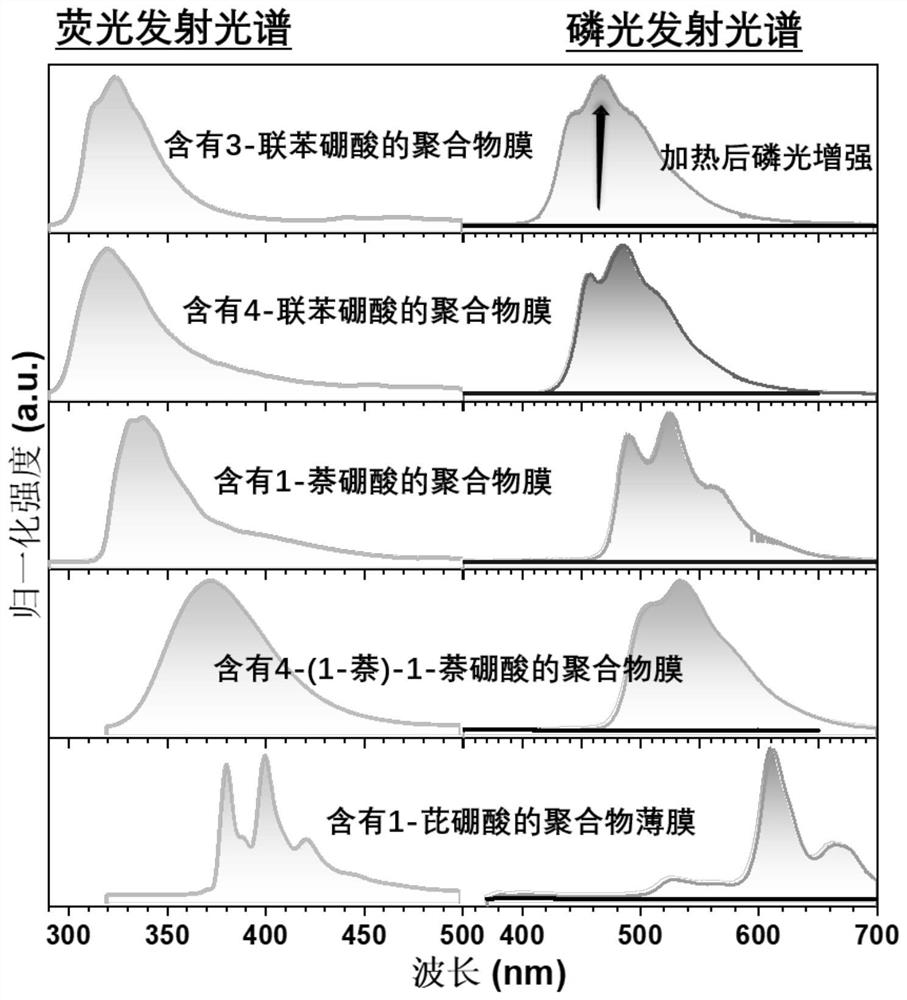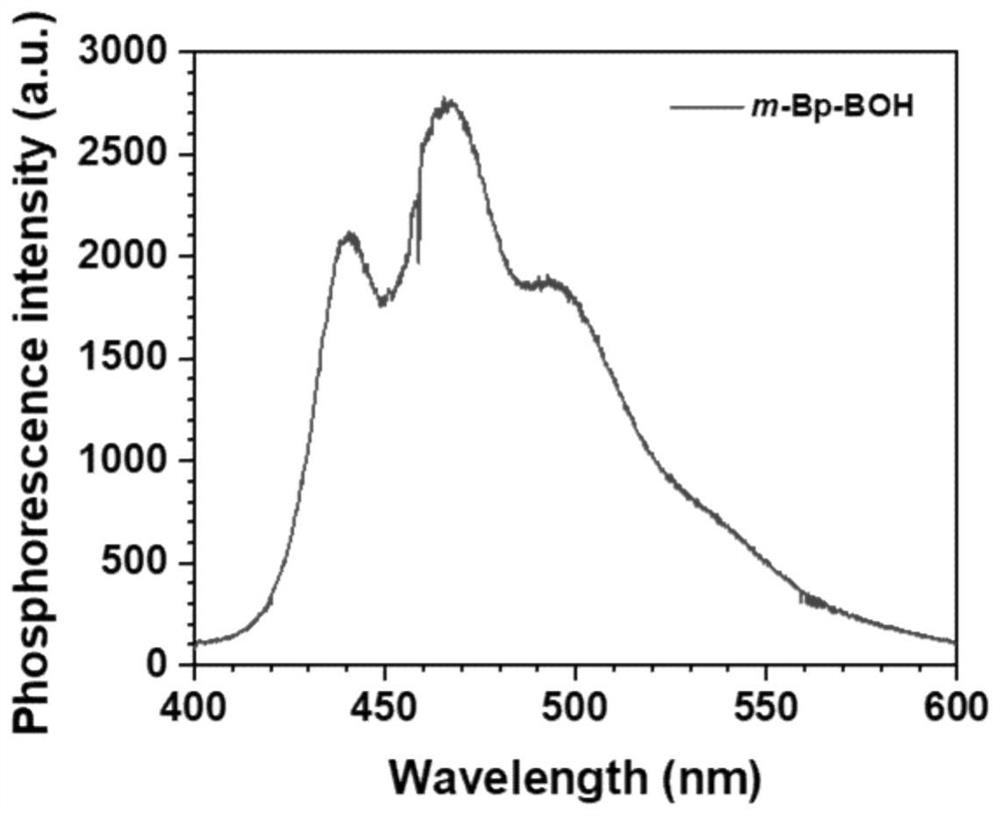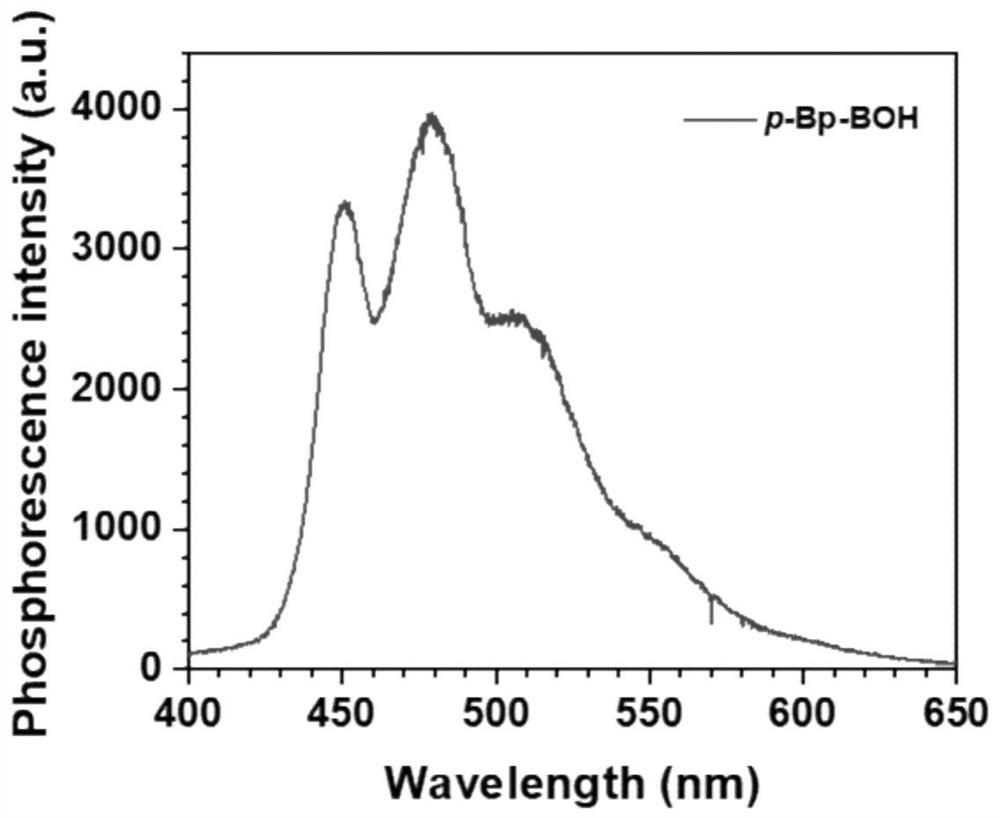Color-adjustable organic room-temperature phosphorescent thin film material with hydrothermal stimulation response and preparation and application of color-adjustable organic room-temperature phosphorescent thin film material
A stimuli-responsive, thin-film material technology, applied in the field of room temperature phosphorescence, can solve problems such as the difficulty of light-emitting materials, and achieve the effects of low price, promotion of room temperature phosphorescence emission, and simple preparation method
- Summary
- Abstract
- Description
- Claims
- Application Information
AI Technical Summary
Problems solved by technology
Method used
Image
Examples
Embodiment 1
[0033] Example 1: Preparation method of organic room-temperature phosphorescent film material with adjustable color in response to hydrothermal stimulation:
[0034] Phosphorescent film material Preparation of polymer film (m-Bp-BOH-PVA) with structural formula (VII) containing 3-biphenylboronic acid.
[0035]
[0036] Polyvinyl alcohol is selected as the rigid matrix polymer, and 3-biphenylboronic acid is selected as the phosphorescent chromophore. Stir 3 mL of 160 g / L polyvinyl alcohol aqueous solution, 4 mL of 1.25 g / L 3-biphenylboronic acid aqueous solution and 1 mL of ammonia water at 80°C for 30 min. Take 0.7mL of the prepared aqueous solution and drop it on the coverslip. Then, heat the coverslip at 80°C until all the water evaporates, and cool to room temperature to obtain a polymer film containing 3-biphenylboronic acid.
Embodiment 2
[0037] Example 2: Phosphorescent film material Preparation of polymer film (m-Bp-BOH-PVA) with structural formula (VII) containing 3-biphenylboronic acid. Polyvinyl alcohol is selected as the rigid matrix polymer, and 3-biphenylboronic acid is selected as the phosphorescent chromophore. Stir 3 mL of 500 g / L polyvinyl alcohol aqueous solution, 4 mL of 1 g / L 3-biphenylboronic acid aqueous solution and 0.5 mL of ammonia water at 65°C for 20 min. Take 0.7mL of the prepared aqueous solution and drop it on the coverslip. Then, heat the coverslip at 90°C until all the water evaporates, and cool to room temperature to obtain a polymer film containing 3-biphenylboronic acid.
Embodiment 3
[0038] Example 3: Phosphorescent film material Preparation of a polymer film (m-Bp-BOH-PVA) with structural formula (VII) containing 3-biphenylboronic acid. Polyvinyl alcohol is selected as the rigid matrix polymer, and 3-biphenylboronic acid is selected as the phosphorescent chromophore. Stir 3 mL of 300 g / L polyvinyl alcohol aqueous solution, 4 mL of 3 g / L 3-biphenylboronic acid aqueous solution and 5 mL of ammonia water at 90°C for 10 min. Take 0.7mL of the prepared aqueous solution and drop it on the coverslip. Then, heat the cover glass at 65°C until all the water evaporates, and cool to room temperature to obtain a polymer film containing 3-biphenylboronic acid.
PUM
 Login to View More
Login to View More Abstract
Description
Claims
Application Information
 Login to View More
Login to View More - R&D
- Intellectual Property
- Life Sciences
- Materials
- Tech Scout
- Unparalleled Data Quality
- Higher Quality Content
- 60% Fewer Hallucinations
Browse by: Latest US Patents, China's latest patents, Technical Efficacy Thesaurus, Application Domain, Technology Topic, Popular Technical Reports.
© 2025 PatSnap. All rights reserved.Legal|Privacy policy|Modern Slavery Act Transparency Statement|Sitemap|About US| Contact US: help@patsnap.com



